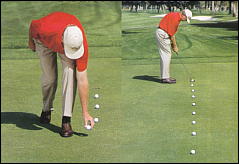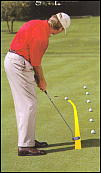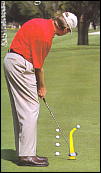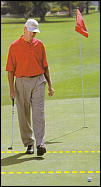
2005 PGA National Teacher of the Year
GOLF Magazine Top 100 Instructor
PGA Master Professional
GOLF Magazine Top 100 Instructor
PGA Master Professional
Take your Golf Game to the next level
GOLF TIPS

Starting with the nearest ball, try to roll each putt over the front edge of the hole. When you finish, replace the balls and repeat the drill. With some practice, you'll develop a feel for the tempo required to roll a ball one additional stride. In time, you'll have a stroke for putts of every length, simply by thinking in terms of your stride. Then you can easily pace off putts on the course and fit them to the system you've created. Better yet, the system is adaptable by simply adjusting tempo based on green speed. Your stride is still your stride.

This putt also breaks right to left about eight inches, but I'm still thinking about rolling the ball like a straight six-pacer; I just aim eight inches out to the right. Because I'm confident in the pace of my putt, I can easily determine break. I know the slope will take the ball to the hole and will take about one pace off the speed.

Like the uphill putt, simply play it like a straight putt, aiming eight inches left of the hole to allow for the break. Use the pace system to determine the effort required, but don't think of any putts as big breakers; play them straight, just adjust your aim.

As a rule of thumb on two-tiered putts, add or subtract the number of paces you step off on the actual hill separating the tiers. For example, if you take two steps on a downslope that bisects a 10-pace putt, play it like an 8-pacer. The reverse holds true for putting uphill over a tier: I would add two to my pace count and hit it like a 12.
But before you consider all the possible variations, develop a feel on the practice green for flat putts from one to 10 strides. Once you do, you'll find this system an excellent starting point for simplifying every putt you face.